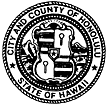
Vision teams survive
with new funding ruleThe city ceases the practice of
earmarking money to each team
The city's vision team process is being revamped without a criticized method of earmarking a set amount of funding to each team for millions of dollars in construction projects.
"We were trying to solve many things by this ... new format. One is the entitlement of the money, whether it's to the neighborhood board or the visions, (that) has raised concerns with the Council members," Managing Director Ben Lee said.
"I think it has been a good process, and we don't want the money to be a divisive element. And I think it was doing that."
Lee announced changes just as the City Council's Budget Committee was about to take up two resolutions aimed at reforming the vision team process. One of the bills sought a moratorium on vision team and neighborhood board projects for two years, and the other called on vision teams and neighborhood boards to only spend their allocated money on road maintenance.
Since the program began in 1998, the 19 vision teams received $2 million each year for projects. Last year, that was reduced to $1 million.
The neighborhood boards first received $1 million, and last year received $500,000.
The committee deferred the resolutions with a wait-and-see attitude.
"The new proposal takes away the kind of onerous things that we didn't like about it: giving the money away, focusing in on nonvision projects," Council Chairman Gary Okino said. "Now it does come more in line with what we're looking for."
Lee said the vision teams will meet quarterly instead of monthly, looking at regional and islandwide issues related to crime, the environment, the economy and transportation.
The "poster boy project" would be something like the Pearl Harbor Historic Trail, which is a good example of not only a community project, but a regional one that touches on several points, economic development opportunities, restoring the historic railroads and preserving wetlands, Lee said.
The goal is also to move vision teams away from "mortar and bricks" construction projects and move them toward more broad, long-term plans, Lee said.
The teams will submit their project proposals to the administration, which will make the final decision on which projects will make it into the operating or capital improvement budget each year.
The changes were generally well received.
"I think that's a move in the right direction," John Steelquist, a neighborhood board and vision team member, told the committee.
Tom Heinrich, chairman of the Manoa Neighborhood Board, said, "It does change the dynamics, which has caused a lot of concern for many people and gets it back more on point."
Councilman Charles Djou, who introduced the bill on the moratorium, said he believes not all the concerns will be resolved by the changes to the visioning process, including whether vision teams are needed because of what he sees as the duplication of functions between the vision teams and neighborhood boards.
